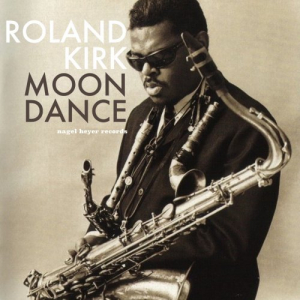Rahsaan Roland Kirk - Moon Dance - Ballads and Soul '2016

| Artist | Rahsaan Roland Kirk Related artists |
| Album name | Moon Dance - Ballads and Soul |
| Country | |
| Date | 2016 |
| Genre | Jazz |
| Play time | 1:17:42 |
| Format / Bitrate | Stereo 1420 Kbps
/ 44.1 kHz MP3 320 Kbps |
| Media | CD |
| Size | 467 MB |
| Price | Download $3.95 |
Order this album and it will be available for purchase and further download within 12 hours
Pre-order album Tracks list
Tracks list
Tracklist: 1. Our Love Is Here to Stay (04:52) 2. Moon Ray (06:41) 3. Three for Dizzy (05:14) 4. The Haunted Melody (03:38) 5. Fly Me to the Moon (06:41) 6. Time (03:12) 7. A Sack Full of Soul (04:38) 8. Funk Underneath (06:18) 9. Moon Song (That Wasn't Meant for Me) (04:22) 10. Some Other Spring (03:31) 11. You Did It, You Did It (02:29) 12. Doin' the Sixty-Eight (04:24) 13. Too Late Now (03:54) 14. Three for the Festival (03:09) 15. Soul Station (05:28) 16. Snap Crackle (04:11) 17. Our Waltz (04:54)  moreKirk was born with sight, but became blind at the age of two. He started playing the bugle and trumpet, then learned the clarinet and C-melody sax. Kirk began playing tenor sax professionally in R&B bands at the age of 15. While a teenager, he discovered the "manzello" and "stritch" -- the former, a modified version of the saxello, which was itself a slightly curved variant of the B flat soprano sax; the latter, a modified straight E flat alto. To these and other instruments, Kirk began making his own improvements. He reshaped all three of his saxes so that they could be played simultaneously; he'd play tenor with his left hand, finger the manzello with his right, and sound a drone on the stritch, for instance. Kirk's self-invented technique was in evidence from his first recording, a 1956 R&B record called Triple Threat. By 1960 he had begun to incorporate a siren whistle into his solos, and by '63 he had mastered circular breathing, a technique that enabled him to play without pause for breath. In his early 20s, Kirk worked in Louisville before moving to Chicago in 1960. That year he made his second album, Introducing Roland Kirk, which featured saxophonist/trumpeter Ira Sullivan. In 1961, Kirk toured Germany and spent three months with Charles Mingus. From that point onward, Kirk mostly led his own group, the Vibration Society, recording prolifically with a range of sidemen. In the early '70s, Kirk became something of an activist; he led the "Jazz and People's Movement," a group devoted to opening up new opportunities for jazz musicians. The group adopted the tactic of interrupting tapings and broadcasts of television and radio programs in protest of the small number of African-American musicians employed by the networks and recording studios. In the course of his career, Kirk brought many hitherto unused instruments to jazz. In addition to the saxes, Kirk played the nose whistle, the piccolo, and the harmonica; instruments of his own design included the "trumpophone" (a trumpet with a soprano sax mouthpiece), and the "slidesophone" (a small trombone or slide trumpet, also with a sax mouthpiece). Kirk suffered a paralyzing stroke in 1975, losing movement on one side of his body, but his homemade saxophone technique allowed him to continue to play; beginning in 1976 and lasting until his death a year later, Kirk played one-handed. © Chris Kelsey Roland Kirk - Moon Dance - Ballads and Soul.rar - 467.0 MB
Related artists
Rahsaan Roland Kirk
Album
- Paris, February 22, 1970 Live In Paris Vol. 1, Vol 2
- November 9, 1956 - June 7, 1960 Third Dimension & Beyond
- 2022 Europe Live 1970
- 2019 Early Days/Triple Threat (Remastered)
- 2016 Moon Dance - Ballads and Soul
- 2005 Copenhagen Concert (2CD)
- 2002 The Man Who Cried Fire
- 1998 Aces Back To Back
- 1997 Dog Years In The Fourth Ring
- 1996 I, Eye, Aye (Live At Montreux Jazz Festival)
- 1993 Does Your House Have Lions
- 1978/2015 The Vibration Continues: Retrospective Of Years 1968-76
- 1977/1978 Kirkatron/Boogie Woogie
- 1977 Kirkatron [2]
- 1977 Boogie Woogie String Along For Real
- 1976 Other Folks' Music
- 1975 The Return Of The 5000 Lb. Man
- 1975 The Case Of The 3 Sided Dream In Audio Color
- 1974 Bright Moments
- 1973 Prepare Thyself To Deal With A Miracle
- 1972 Introducing Rahsaan Roland Kirk
- 1972 I, Eye, Aye
- 1971 [2014] Natural Black Inventions: Root Strata
- 1971 Blacknuss
- 1969 Volunteered Slavery (Reissue 2005)
- 1968 Left & Right (2011 Remastered)
- 1966 Slightly Latin
- 1965 Here Comes The Whistleman
- 1964 [1998] I Talk With The Spirits
- 1962; 2019 Domino (Remastered)
- 1962 Early Roots: The Bethlehem Years
- 1961 We Free Kings
- 1961 Kirk's Work
- 1954 Kirk In Copenhagen
Compilation
- 1990 Rahsaan - Complete Mercury Recordings (1961-65) (CD1)
- 1990 Rahsaan - Complete Mercury Recordings (1961-65) (CD2)
- 1990 Rahsaan - Complete Mercury Recordings (1961-65) (CD3)
- 1990 Rahsaan - Complete Mercury Recordings (1961-65) (CD4)
- 1990 Rahsaan - Complete Mercury Recordings (1961-65) (CD5)
- 1990 Rahsaan - Complete Mercury Recordings (1961-65) (CD6)
- 1990 Rahsaan - Complete Mercury Recordings (1961-65) (CD10)
- 1990 Rahsaan - Complete Mercury Recordings (1961-65) (CD11)
- 1990 Rahsaan - Complete Mercury Recordings (1961-65) (CD8)
- 1990 Rahsaan - Complete Mercury Recordings (1961-65) (CD7)
- 1990 Rahsaan - Complete Mercury Recordings (1961-65) (CD9)
- 1978 The Vibration Continues
Live album
